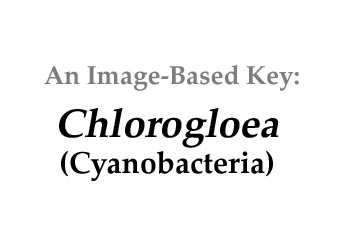|
Home / Cyanobacteria / Colonies / Chlorogloea |
||||
|
|
||||
|
Click on images for larger format |
||||
Name derivation: |
||||
|
|
||||
Classification: |
||||
|
Chlorogloea Wille, N. 1900; 19 of 28 species (and infraspecific names) are currently accepted taxonomically. Order Chroococcales; Family Entophysalidaceae
|
||||
Morphology: |
||||
|
Unicellular and colonial. Colonies are irregular and gelatinous. Structure is more or less spherical, hemispherical, or flat. Microscopic to macroscopic. Either attached to substrate or free living, epipelic or in metaphyton. Single microcolonies can form together into gelatinous masses. Mucilage cell colonies are usually in rows (some indistinct), or sometimes are oriented radially or parallel. Lack envelopes, usually. Cell shape is either spherical, ellipsoidal, or irregular. Coloration varies as blue-green, gray, pale olive green, yellow, or red, with fine granular content. Cells divided into three or more planes in successive generations. Original size is generally reached before next division. Also described are planocyte and nanocyte formations. Reproduction is usually through fragmentation of colonies in multi-cell mucilaginous clusters. (Guiry and Guiry 2014). |
||||
Similar genera: |
||||
Nitrogen fixation: |
||||
|
Chlorogloea sp. was able to fix nitrogen on a strictly inorganic medium in light. Chlorogloea sp. was also able to fix nitrogen in the dark with suitable organic substrate. Under certain conditions Chlorogloea sp. adapts to heterotrophic growth in the dark (Fay. 1965). Chlorogloea was able to utilize organic substances in bot light and dark situations. The two metabolic pathways were extremely different. The light pathway was more similar to other blue-green bacteria in light than to the pathway in the dark (Miller and Allen. 1972). |
||||
Photosynthetic lamellae: |
||||
|
At more intense light levels, the photosynthetic lamellae were less abundant, fragmented and were found frequently swollen. At lower light levels the lamellae were found to be in groups of four to six, and tightly compact with no signs of swelling (Findley et al. 1970). |
||||
Habitat: |
||||
|
Type species and two other species are known from marine littoral (epiphytic or epilithic). Two species from hypersaline lakes in central-Asiatic USSR and in Egypt deserts. Most species are described from freshwater biotopes, usually from littoral and benthos of lakes and mountain creeks. One species is aerophytic and grow on limestone rocks in caves and shaded places. Two species are known only in the tropics. Two species only from the Antarctic (Guiry and Guiry 2014). |
||||
References: |
||||
|
Guiry, M.D. and G.M. Guiry 2014. AlgaeBase. World-wide electronic publication, National University of Ireland, Galway. http://www.algaebase.org; searched on 04 September 2013. Wille, N. 1900. Algologische Notizen I-VI. Nyt Magazin for Naturvidenskaberne 38(1): 1-27. Miller, J.S. and M.M. Allen 1972. Carbon utilization patterns in the heterotrophic blue-green algae Chlorogloea fritschii. Archives of Microbiology 86(1): 1-12. Fay, P. 1965. Heterotrophy and nitrogen fixation in Chlorogloea fritschii. Journal of General Microbiology 39: 11-20. Findley, D.L., P.L. Walne and R.W. Holton 1970. The effects of light intensity on the ultrastructure of Chlorogloea fritschii mitra grown at high temperature. Journal of Phycology 6: 182-188. |
||||

